|
| Author |
Message |
WGL
Member
|
# Posted: 19 Sep 2016 06:55pm
Reply
I am going to start building my new camp very soon and one problem I have to solve is how to keep the waterline from freezing in between the long periods of time that I am not there. I am off-grid, heat with wood and draw my water from the lake that is 100ft. away. I have a permit to bury the pipe below frost line from the camp out into the lake but am concerned about from the frost line up into the camp. I think I am going to build the camp on a full foundation but may opt to build on posts. Any experts out there that could share their thoughts. 
|
|
DaveBell
Moderator
|
# Posted: 19 Sep 2016 07:18pm
Reply
I would drain the line. Simply unpressuring the line and let gravity to the work. Take the pump home so it doesn't get stolen. When you build, you need to insulate the line from 2-3 feet down up into the cabin floor so the line is part of the cabin heat envelope. Use a 12 inch pipe or duct work from the bottom of the hole to the floor of the cabin and then stuff it with insulation. I would also build an air tight 4'x4' box from the ground up to the cabin floor to transfer more of the cabin heat envelope.
|
|
hueyjazz
Member
|
# Posted: 19 Sep 2016 07:46pm
Reply
I agree with draining the lines and engineering it so its easy to do so. Anything that can trap water, will and will freeze. You will need to blow out lines. However, supply lines are only half the equation. Drain lines will also be suspect. You can glycol them and use expanding rubber P traps.
|
|
Just
Member
|
# Posted: 19 Sep 2016 08:41pm
Reply
should work
|
|
bldginsp
Member
|
# Posted: 19 Sep 2016 11:40pm
Reply
Designing your whole system so that all pipes drain can take a bit more thought than you might think. Any place water can collect can be the source of a leak from ice expansion. Tankless water heaters are very vulnerable, as are shower mixing valves. Some people use systems that fill the pipes with a water/glycol mix. Glycol is edible so it's not a problem. Propylene glycol, that is. Ethylene glycol is a lethal poison.
In order to get my whole plumbing system to drain, I installed a drain line and valve underground outside the cabin which I will have to access when I leave in winter, and open to drain. You can use those sprinkler valves that are operated with a long tool from above. But of course the drain line has to be lower than everything else or it won't drain it, so if you have a deep frost depth your drain will require more digging than the supply pipe.
I also will have a small air compressor with fittings connected to the piping system to blow it out.
Pex piping is supposedly less susceptible to damage from freezing, but not sure I'd rely on that and leave a Pex system undrained.
|
|
RichInTheUSA
Member
|
# Posted: 20 Sep 2016 12:32pm
Reply
Supply lines, such as to a faucet, need to be able to have air intake so that the water drains out. I generally open the sink and tub valves to allow air in, so the water drains.
On my washing machine, there are water supply lines for the hot and cold water... I ended up putting "Y"s on them, so that I could easily allow air into the system. Yes, I learned this the hard way... as those supply lines will freeze up too if you don't actually get them drained.

|
|
tverga
Member
|
# Posted: 20 Sep 2016 02:54pm - Edited by: tverga
Reply
I designed all my supply lines to slant towards the lowest part of the system. The outside hose valve is the lowest point so all I have to do is turn off the well at the hydrant and open the faucets at the sink and shower. I also lift the hoses feeding the washer to drain them. The system, drains 1-2 minutes I pour RV antifreeze in the drains and toilet. All done in less than 5 minutes and I don't have to crawl under the house.
We use a tank-less water heater, I am sure it never fully drains but we have not had an issue.
I have a friend that uses compressors and a ton of fittings, he claims every drop of water needs to be out. That is just not true, you need to get enough out so what remains can freeze and expand without putting pressure on the pipes.
I would recommend that if you are building a new cabin make sure your plumbing runs are accessible behind panels or crawlspaces.
|
|
Asher
Member
|
# Posted: 20 Sep 2016 03:24pm
Reply
My old set up worked pretty good.. Lowest point was the outside faucet. After turning off the water at the source, I would open the outside faucet then go inside and open all the valves.. Then I made a adapter to screw onto the faucet that attached to the shop vac.. Turn on the shop vac and suck out anything left..
|
|
|
WGL
Member
|
# Posted: 23 Sep 2016 09:22am
Reply
Thanks everyone for your input, all valid points. I will definitely be using pex lines and pitching them to facilitate draining. From the research I have done and as suggested here I think the " freeze proof hydrant " will be the way to go so I can use my camp occasionaly in the winter months. I plan on sharing my project pictures once the work begins.
|
|
Nate R
Member
|
# Posted: 23 Sep 2016 10:36am
Reply
Be aware that while PEX PIPE is more freeze resistant, the brass fittings aren't! 
|
|
creeky
Member
|
# Posted: 23 Sep 2016 11:01am
Reply
Quoting: Just no freeze hydrent
what I have. along with white pex.
you'll be surprised what you can absorb.
(I heat all winter long. in a very cold climate. travel a lot. and have been through multiple freeze ups. Okay. who forgot to check the propane?)
i now have a shower where only one tap works. a patch on my hot water heater. a slow leak on one pump.
I should probably put in a "quick drain" system of some sort.
|
|
Big Ed
Member
|
# Posted: 8 Jan 2017 03:27am
Reply
Quote from WGL
"I am going to start building my new camp very soon and one problem I have to solve is how to keep the waterline from freezing in between the long periods of time that I am not there."
Are you planning on keeping the water system in use through the winter?
|
|
WGL
Member
|
# Posted: 8 Jan 2017 09:37am
Reply
Yes, I would like to if possible.
|
|
FishHog
Member
|
# Posted: 8 Jan 2017 09:48am
Reply
to me its not worth the hassle through the cold months. You only have a few options. Drain (and it won't freeze), but you need to drain everything, every time you leave. Heat what you don't want to freeze. (tough when off grid and gone for long periods). Or keep some water flowing all the time, but again, tough to do when gone for long periods.
I drain in the fall. Go back to the old school ways for a few winter trips and turn it back on in the spring. The alternatives just aren't worth the effort/cost to me.
|
|
Big Ed
Member
|
# Posted: 8 Jan 2017 01:21pm
Reply
WGL, that's what I thought you meant, I'm also wanting to have water through the winter. I've been researching it, and also brainstorming ideas of my own.
This idea uses a large colapsable water tank in the crawl space.
http://rainwaterpillow.com/index.php/media-channels/blog-rainwater-harvesting-news/10 4-need-a-year-round-water-supply-for-your-remote-cabin
I also saw one that used heating coils around the pipe in the ground.
http://alaskauu1.blogspot.com/2013/11/advice-for-potential-homesteaders-water.html
I saw another one that had a water tank in an underground room. Everything was underground, until it came up into the cabin. I'm not sure that one was in a cold area though, I will have to find it again.
There was also one that said they draw water from the middle diameter of the tank towards the bottom, only the outside edges froze. I will have to find and link it.
These ideas are from people that remain in the cabin through the winter, or keep the heat on when they're gone. Of course the extreme you will have to go to depends on what part of the country you're in, and exactly how cold it gets. The area I'm looking at only gets into the twenties and teens.
|
|
Big Ed
Member
|
# Posted: 8 Jan 2017 01:37pm
Reply
I just found this one too.
http://countryplans.com/smf/index.php?topic=13092.new#new
|
|
Big Ed
Member
|
# Posted: 8 Jan 2017 01:56pm
Reply
I found the one that references the tank in an underground room, and an above ground tank only freezing around the edges.
https://www.survivalmonkey.com/threads/water-tank-above-ground-or-below.32251/page-2
|
|
SE Ohio
Member
|
# Posted: 8 Jan 2017 05:34pm
Reply
A low tech approach is using an old-fashioned pitcher pump, available from Tractor Supply, Lehmans, and others. A regular pitcher pump can draw water up 20-25' (don't know your elevation change). These are frost proof in that the water drains from the pump, so you don't have to winterize it. Water is only in the line as you pump it, draining back shortly thereafter. You can use it like this all winter long, but it is a bit short of running water. We hand pump water with a pitcher pump, then heat it on the stove for dishes, shower (using 12 volt submersible pump), etc.
Our sink has a rubber trap, that can freeze with no damage.
I don't have to winterize/drain anything, just turn off the (solar/battery powered) lights when I leave on Sunday. I'm a bit on the lazy side I guess... But I use the cabin often during the winter and don't want the extra worries.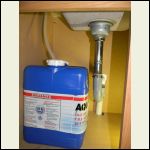
Flexible sink trap
| 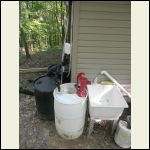
Pitcher pump on rain barrel
| 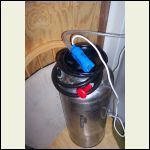
Shower tank and immersible 12 v pump
|  |
|
|
Wendigolake
Member
|
# Posted: 8 Jan 2017 06:42pm
Reply
Something that might be possible for some people, is what we did at my farm in eastern Ontario. The pump house was dug about 7 ft below grade. The roof was sloped just enough to drain any water off it and it was pretty close to ground level. We concreted the walls and the pipe out of the well fed into the pump house through the wall about a 1.5 ft above the floor. We had the pump and pressure tank in there and never had a freeze problem in the 20 yrs I lived there. The pipe into the house was buried below the frost level and came into the basement. Just a thought for anyone putting in a pump and looking to not have to remove it every winter.
|
|
Big Ed
Member
|
# Posted: 8 Jan 2017 07:59pm
Reply
SE Ohio, your 3rd pic won't enlarge. I like the first two, good contribution to the thread.
Wendigolake, that's along the lines i was thinking would be a bullet proof setup. Not cheap or easy though. Any pictures? I can visualize it. The property my wife and I are looking at is sloped, so it would facilitate underground rooms, and gravity flow.
|
|
Big Ed
Member
|
# Posted: 8 Jan 2017 10:55pm
Reply
Wendigolake, your well was above ground, and not in the pump house? No problems with freezing? So at the well itself it's just a pipe elbow going into the ground? I guess the water would just drop back out.
|
|
wgiles
Member
|
# Posted: 9 Jan 2017 11:40am
Reply
If you put a submersible pump in the lake, it will have a check valve at the outlet and your waterline to the lake will not drain. If you use a shallow well jet pump, you will have a foot valve at the inlet in the lake and your waterline to the lake will not drain. You can disable the check valve on a submersible pump and the line will drain back through the pump, but you have to have a check valve somewhere or you will lose all of your pressure when the pump kicks off and the pump will just cycle on and off. You can put a check valve at the inlet of a shallow well jet pump and it will hold pressure, but the pump may lose it's prime when it shuts off if there is a small leak in the suction line to the lake. A shallow well jet pump is only good for around 20 Ft. of suction lift at best. If there is too much suction lift, you will need to put your pump closer to water level. Also be aware that ball valves trap water in the ball (and in the cavity housing the ball) and can burst if they freeze while closed. When draining a line with ball valves it is best to put the valve handle in a 45 degree position so that the ball and cavity can drain with the line. Your pressure tank also needs to be completely drained during freezing weather, although pressure tanks often survive freezing because of the expansion chamber. You can build a buried pump pit that is deep enough and insulated enough that it will not freeze and put your pump and pressure tank in it. If you have a drain in your pit, you can drain your supply line and /or your pump and pressure tank when you are gone. If you don't drain your pump and pressure tank, you won't have to reprime when you return. If you use a submersible pump and a buried pressure tank, you only have to drain the supply line and your system will be ready to go when you turn the pump power on. It is possible to bury a fiberglass captive air pressure tank and connect the air side to a pressure switch above ground. To do this, you need to remove the valve core from the air pressure fitting on the tank and make an adapter to connect some plastic tubing to the air valve threads. You then run the plastic tubing out of the ground to your pressure switch. At the pressure switch, you install a tee with a pressure tank air valve (Schrader valve) and connect your tubing to the tee. You then pressurize your pressure tank with compressed air to the required pressure. In order to check your pressure tank air pressure, you need to shut your water pump off and drain all of the water pressure. The air pressure should be just below the turn on pressure setting of your pressure switch. To drain your water lines for freeze protection, you need a shut off valve at the pressure tank connection to your water line and a drain valve on your supply line. These valves will be buried, so you have to extend the handles above ground. Since your drain valve is below the frost line, your drain line doesn't have to drain completely. If it doesn't drain completely and water freezes in the drain line, you will not be able to drain your system when the temperature is below freezing. You could fill the drain line with RV antifreeze after draining to keep it from freezing or use compressed air to blow the water out. All of this requires taking a good look at the topography between the cabin and lake and seeing if there is a good place for a buried air tank. Plastic tubing above ground needs to be protected from rodents. They love to chew on the plastic to sharpen their teeth.
|
|
Big Ed
Member
|
# Posted: 9 Jan 2017 03:03pm
Reply
How about a tee and quarter turn valve right before the check valve, up top. The system would work fine until you are done with it and want it to drain back into the lake, then you open it.
|
|
wgiles
Member
|
# Posted: 9 Jan 2017 03:11pm
Reply
If you have a submersible pump, it should work, as long as the check valve in the pump is disabled. If it's a shallow well jet pump, it might work, but the pump needs to be protected from freezing and the pump could lose prime if any air gets into the line. If the pump is above ground, it will need to be drained anyway.
|
|
SE Ohio
Member
|
# Posted: 13 Jan 2017 02:03pm
Reply
Quoting: Big Ed SE Ohio, your 3rd pic won't enlarge.
Don't know why photo won't enlarge. Took a while to find more pictures... Anyway, we have 12 volts DC from solar power. We heat up water in a (metal) Zodi tank, but any large heatable container would do. We heat this on the stove (Zodi tank has thermometer on side) and when ready, we drop in the pump. Bilge pump won't damage if run dry like some pumps. Connected to pump is flexible tubing, this is connected to low-flow shower head (free from Columbia Gas Company, also check online). This provides about 1 gallon per minute on the shower, so plan accordingly. We take a "Navy Shower", in that we turn water on, get wet, water off, soap up, water on, rinse, then off. We can get three non-luxurious showers from this! Not for everyone, but I prefer this to having to worry about draining pipes at the end of each winter visit.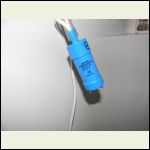
12 volt bilge pump
| 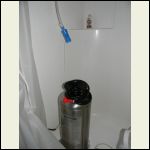
Water tank
|  |  |
|
|
FishHog
Member
|
# Posted: 13 Jan 2017 03:37pm
Reply
SE Ohio, I use the same zodi, but stick with their pump that comes with the tank. Quick on/off showers and its fantastic. Tonnes of water for 2 showers, and as you say will do 3 if needed. I used this for years before I had running water, but still use this in winter months. Simple and effective.
|
|
Wendigolake
Member
|
# Posted: 13 Jan 2017 07:49pm
Reply
Big Ed....,
my well was a drilled well. The pipe was down about 90 ft and came through the wall just above the floor in the pump house.
|
|
Jquinn782002
Member
|
# Posted: 18 Apr 2019 05:37pm - Edited by: Jquinn782002
Reply
All of this information has been very handy for myself now going into my own cabin that is only a two season. Thank you everyone for your input
|
|
KinAlberta
Member
|
# Posted: 21 Apr 2019 08:41am - Edited by: KinAlberta
Reply
Not sure if this has been mentioned but I’ve seen large diameter rock wool pipe insulation. So one could slide a few layers of this stuff over the pipe and then slide it all into say an 18†diameter section of a fairly non conductive tube so that the cold air temperature doesn’t lead to a freezing of the ground.
Some inside diameters have been so large 10-22†outside diameter) that one common sized pipe insulator could fit inside the larger ones.
https://en.m.wikipedia.org/wiki/Mineral_wool#/media/File%3ARochwool_pipe_covering_wh_ fire_test.jpg
“http://www.knaufinsulation.ca/sites/ca.knaufinsulation.com/files/CI-PE-DS%200319%2 0WEB.pdf
PRODUCT FORMS AND SIZES
Produced in 3' (914 mm) sections
• For iron pipe from 1â„2" to 24" nominal pipe size (15 mm to 610 mm)
• For copper tube from 5â„8" to 61â„8" (16 mm to 156 mm)
• Wall thicknesses from 1â„2" to 6" (13 mm to 152 mm) in single layer (for most sizes)
• All insulation inner and outer diameters
comply with ASTM C585“
|
|
|

